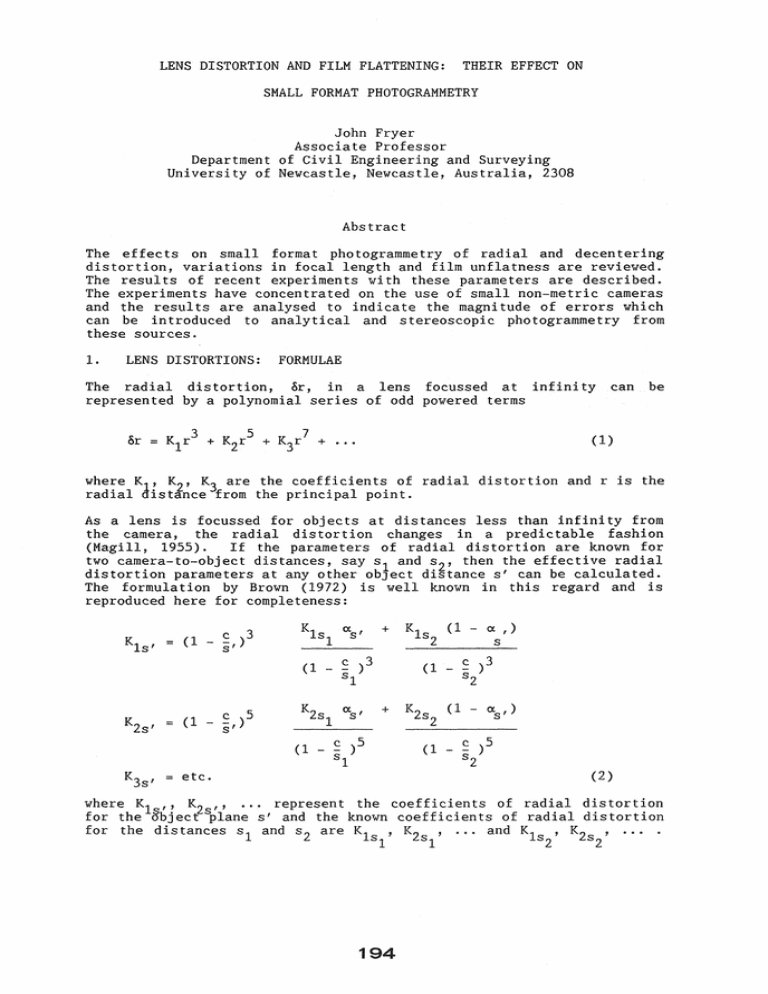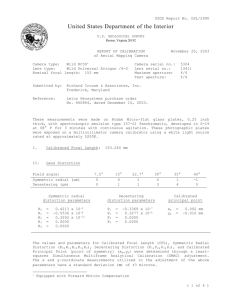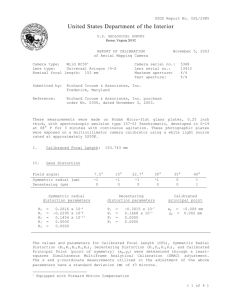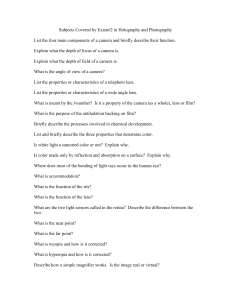LENS DISTORTION AND FILM FLATTENING:
advertisement

LENS DISTORTION AND FILM FLATTENING: THEIR EFFECT ON SMALL FORMAT PHOTOGRAMMETRY John Fryer Associate Professor Department of Civil Engineering and Surveying University of Newcastle, Newcastle, Australia, 2308 Abstract The effects on small format photogrammetry of radial and decentering distortion, variations in focal length and film unflatness are reviewed. The results of recent experiments with these parameters are described. The experiments have concentrated on the use of small non-metric cameras and the results are analysed to indicate the magnitude of errors which can be introduced to analytical and stereoscopic photogrammetry from these sources. 1. LENS DISTORTIONS: FORMULAE The radial distortion, or, in a lens focussed at infinity can be represented by a polynomial series of odd powered terms (1) where K1 , K2 , K3 are the coefficients of radial distortion and r is the radial distance from the principal point. As a lens is focussed for objects at distances less than infinity from the camera, the radial distortion changes in a predictable fashion (Magill, 1955). If the parameters of radial distortion are known for two camera-to-object distances, say sl and s2' then the effective radial distortion parameters at any other object distance s' can be calculated. The formulation by Brown (1972) is well known in this regard and is reproduced here for completeness: K lSI cxs ' + (1 _ ~ )5 s' K2s cx ' 1 s + (1 - ~ )5 sl K3s ' = (1- cx,) 2 (1 _ ~ )3 s2 (1 - ~ )3 sl K 2s' KIs K2 s2 (1- cx,) s (1 - ~ )5 s2 (2) etc. where Kl " K2 " ... represent the coefficients of radial distortion for the 3bject splane Sf and the known coefficients of radial distortion for the distances sl and s2 are K ' K ' ... and K ' K ' 2s2 1s1 2s1 1s2 194 The principal distance in all these formulae is c and as' is given by as' s2 - s' sl - c s2 - sl s' - c (3) Radial distortion also varies for a particular focus setting within the "depth of field", that is, within that range of camera-to-object dis tances which provide an acceptably sharp focus. Suppose tha t the camera mentioned above is not focussed on an object at Sf, but rather on an object plane s. A further parameter yss , must be evaluated as s - C s' - c Sf s (4) before the exact value of the radial distortion or ss ' can be computed as or ss ' (5) = Finally the effect on the x, y image coordinates can be expressed as Ox oy = Yor r ss' (6) Decentering distortion arises as a consequence of the elements in a lens system not being perfectly aligned. The centers of curvature of all the spherical surfaces may not be collinear with the optical axis. Conrady formulated this effect in 1919 for a system assumed to be at infinity focus and Brown (1966) modified it into the form well-known to photogtammetrists. In 1986 it was discovered (Fryer and Brown, 1986) that decentering distortion also varied in a predictable fashion wi th focussing; ax s (1 - ~) [P 1 (r 2 + 2(X-Xp)2) + 2P 2 (x-x p )(y-yp)] 2 (7) (1 - ~) [P (r + 2(y_yp)2) + 2P (x-x )(y-yp)] 2 l p s where the parameters PI and P2 are the values at infinity focus of the decentering distortion; ax, 6y are the components of decentering distortion at an image poin~ x, 1; r is the radial distance to the image point and c is the principal distance for a lens focussed on an object plane a distance s from the camera. 6y Equation 7 is only rigorous for points on the plane of focus and the right hand side must be modified by the factor y , (equation 4) to calculate the decentering distortion of a point whi~R lies on an object plane a distance Sf from the lens. 195 It should be noted that whilst the formulae for radial distortion can vary very significantly wi th focussing, (and somewhat less wi thin the depth of field), the magnitudes of the corresponding variations one is likely to experience with decentering distortion are quite small, probably less than three micrometers. However, for a non-metric camera the total magni tude of the decentering distortion may well exceed 25 micrometers at the edge of the image format and so its presence must be compensated for all serious work. As the distances from the camera to the object points will usually not be known a priori, it will be necessary to iterate the equations after an initial triangulation. The formulae for radial and decentering distortions become much simpler in form if, (i) (ii) the camera is focussed at infinity, one of the distances (usually s2) at which the lens is calibrated is infinity. For a more thorough treatment of the derivation of lens distortions the reader is referred to Fryer and Brown (1986). 2. THE ANALYTICAL PLUMBLINE TECHNIQUE The analytical plumbline method (Brown, 1971) was developed as a rapid practical way of computing lens distortions parameters at a range of magnifications from approximately 5X to 20X. The principle of this technique lies in the fact that straight lines in object space should project through a perfect lens as straight line images. Any variation from straightness is attributed to radial or decentering distortion, and a least squares adjustment is performed to determine the distortion parameters K1 , K2 , K , P and P " 3 1 2 The results of such a lens calibration can be contaminated in practise by uncorrected systematic errors in the comparator, by unflatness of the photographic surface or by uncompensated deformations of film. Such sources of error must be adequately controlled or corrected if non-linearity in measured images of plumblines is to be fully attributed to the lens. It is interesting to speculate that if the film in a non-metric camera consistently deforms in a particular pattern that the lens calibration parameters will partially compensate for that film deformation. Plumbline calibrations performed in the late 1960s typically had one sigma values of about two micrometers. Time taken to gather the data on a precise manually operated comparator was of the order of one day and the technique remained unchanged until the mid-1980s when the fully automatic computer controlled monocomparator Autoset-1 was developed by Geodetic Services Inc., Florida (Fraser, 1986). Fryer (1986a) describes in some detail the operation of Au toset-1 wi th images of plumblines. Fryer and Fraser (1986) further detailed the use of the technique for the calibration of the lenses of underwater cameras and underwater camera housings. The extrapolation of the plumbline technique from the imaging of near vertical string-lines in a laboratory to the photography at infini ty focus of man-made straight objects such as long glass panels in 196 mul ti-storey buildings has been reported (Fryer, 1987). Coupled wi th this ease of obtaining photography sui ted to an infini ty focus lens calibration, the analytical stereoplotter MPS-2 (Elfick, 1986) has a plumbline calibration program which allows a user to quickly measure and calculate the parameters of radial and decentering distortion prior to observation of other photography taken with the same lens system. This process is not fully automatic like Autoset-1, but nevertheless the lens calibration procedure can be completed for small formats in under one hour. 3. 3.1 IMPROVING THE PHOTOGRAMMETRY ACCURACY AND PRECISION OF SMALL FORMAT Radial Distortion The accuracy and precision of photogrammetric networks improves with the inclusion of a small selection of additional parameters to the process of the bundle adjustment. However, Fraser (1982) indicates that whilst the continued inclusion of addi tional parameters may improve internal consistency (precision), the absolute accuracy of the computed coordinates may deteriorate. The selection of the most suitable additional parameters is therefore very important. The parameter K1 , the first term in the radial distortion equation, has been shown to nave a very considerable effect in reducing the size of plate residuals and improving the accuracy of photogrammetric adjustments. Karara and Abdel-Aziz (1974) used four different non-metric cameras to conduct a series of experiments concerning the addition of extra coefficients to the Direct Linear Transformation method of solution. The rms values of the residual plate errors decreased by a factor varying from two to seven times with the addition of K1 to the solution. Similarly, Murai et al (1984) evaluated the inclusion of differing numbers of additional parameters to the photography taken from a range of small format non-metric (Olympus, Nikon and Hasselblad) and metric (Wild P-32) cameras. The parameters K1 and K? of radial distortion again caused the most improvement to the rms of toe plate residuals. In fact, the precision of the non-metric cameras approached that of the metric camera with the addition of these parameters. Several tests conducted by this author using space resectionl intersection software and bundle adjustments have confirmed these resul ts, wi th the fac tor of improvement usually about two or three times. The size of the improvement will be related to the magnitude of the radial lens distortion. When the second and third parameters (K and K~) are added to the bundle adjustments, their degree of statistica! signilicance is only marginal al though on occasions the K2 term is useful. For large format aerial cameras the K2 and K3 terms usually improve the results significantly. 3.2 Decentering Distortion Only a slight improvement in rms preC1Slon of plate residuals was noted by Karara and Abdel-Aziz (1974) when the parameters P and P were added 1 2 situation to their solutions. Whilst this has generally oeen tne experienced by this author, the parameters P and P can be related to a 2 (and statistically 1 physical phenomenon and do have a beneficial significant) effect on computed object coordinates. Murai et al (1984) also drew these conclusions. 197 It is interesting to recount the experiences of Fryer and Fraser (1986) when they calibrated some non-metric underwater cameras lenses by both the plumbline technique and a bundle adj us tmen t of eigh t convergen t camera stations. The plumbline technique did not provide a value for x and y , the offsets from the intersection of the fiducial axes to th~ princPpal point, whereas the convergent geometry of the bundle adjustment did provide such values. A large discrepancy (3um compared to 37um) was noted for the decentering distortion profiles derived from the two methods. The values of P and P2 from the plumbline method were 1 then held fixed in the bundle adjustment and the resulting values for x p and y altered by up to O.3mm. p The important result of these calculations was that the values for the coordinates of the object points did not change, proving that it matters little how one determines P1 and P2 as long as their correlation with xp and yp is acknowledged. Another interesting series of experiments was conducted by Fryer (1986b) with a 35-70mm zoom lens attached to a Canon AE-1 Program 35mm camera. The plumbline method was used to determine the radial and decentering distortion characteristics of the lens for a range of focussing distances and at different principal distances throughout the zoom range. The "wobble" of the moveable inner lens of the zoom combination as it tracked along the optical axis was discernable from changes in the parameters of decentering distortion. These results showed the advantages to be gained by using a zoom lens could easily be negated if a thorough lens calibration is not made. In summary, it is quite valid for non-metric small format photogrammetry to artificially hold x and y as zero, use the convenient plumbline technique to determine ~he par~meters K , P and P of lens distortion 2 and then use the analytical methods of space l resection/intersection or a full bundle adjustment to calculate the coordinates of object points. The projective equivalents of x , y with PI' P2 and the camera station location can be used to advanta§e iFt analytlcal stereoplotters designed to operate wi th small format photography which has been taken from a camera without fiducial marks. Providing the corners of the photograph are visible, their intersection can be assumed to be the principal point. A plumbline calibration will provide all the parameters needed to overcome lens distortions. Two of the three elements of inner orientation can be assumed (that is, x and y ), with a value for the principal distance the only remaining urlknown. p 3.3 Principal Distance and Film Unflatness The convention used in this discussion is that the principal distance is the perpendicular distance from the perspective center of the lens system to the image plane. Focal length is that value of the principal distance which corresponds with infinity focus. The constant c has been used in the earlier equations to describe the principal distance at any specific focus setting. The principal distance for a non-metric camera can number of ways but noting the manufacturer's printed of the lens must be the most unreliable! Over the author has tested more than twenty cameras and 198 be determined in a value on the front last few years the lenses and found discrepancies up to 1.5mm in a metric camera of stated principal distance 99.60mm and up to 2.5mm for lenses in non-metric cameras. A relatively simple method for determining the principal distance for a camera/lens combination is to photograph from a known location a set of coordinated targets in a test field. A spread of 50 or more targets across the image format will usually provide a good estimate of the lens distortions as well as the principal distance. A bundle adjustment from four (or so) camera stations arranged with convergent geometry around an array of targets will provide a similar resul t. In this case the coordinates of the targets need not be known so the bundle adjustment technique has a distinct advantage regarding long-term maintenance over a coordinated test field. The advantages of making corrections for radial distortion to image coordinates before using space resection/intersection techniques are well illustrated by the results of Webb (1987). Webb photographed coal stockpiles on which several surveyed control marks were visible. He used a space resection program to solve for the camera station locations (X, Y, Z), the camera's orientation and the principal distance of a non-metric Canon AF35M camera equipped with a nominal 38mm lens. Table 1 shows a selection of his results. The derived principal distances were more consistent when the first parameter of radial distortion was used to correct the image coordinates. Notice also the reduction in the rms values of the plate residuals, confirming the results of the other researchers noted above in Section 3.1. It would seem for these tests that the amount of film unflatness remained constant from one exposure to the next, unlike the large variabili ty in the resul ts of similar tests reported by Ethrog (1984). An important practical consideration in most applications of photogrammetry involves the amount of control which must be provided. The reality of most photogrammetric operations is that little more than a minimum number of control points are es tablished. A consequence of this is that for any individual photograph, the location of the control points will not form an optimum configuration. If the images of these control points are not corrected for lens distortion then a biassed solution for the principal TABLE 1 Principal Distances Computed With and Without a Radial Distortion Correction Applied to Image Coordinates Principal Distances With Image Corrections Principal Distances Without Image Corrections Prine Dist. Plate rms x y (urn) (mm) 38.035 38.039 38.042 38.040 Prine Dist. (mm) 10 9 8 6 10 7 10 6 38.087 38.102 38.114 38.115 199 Plate rms x y (urn) 18 16 16 15 12 9 11 11 distance may result, completely confusing the issue of the size of the film unflatness. In another attempt to analyse the shape of the unflatness of the film in a 35mm camera, Donnelly (1987) conducted a number of experiments. He added a vacuum at tachmen t to the back of a Canon AE-1 Program camera and, with the camera held securely, took a series of exposures of a test grid with glass plates and colour transparency film with and without the vacuum applied. Adopting the glass plate photography as his "standard", he measured the differences in position of 250 targets on the unflattened and flattened film exposures. The rms values of the differences were 25um and 10um respectively. From the distribution pattern of the differences in image positions on the film relative to the glass, it was possible to derive the shape of the film surface. A set of diagrams similar to those published by Fraser (1982) were prepared. From these and some other photogrammetric tests on targets wi th known coordinates, it appears that O.3mm to O.8mm is the "usual" amount of unflatness in 35mm films. The value calculated for the principal distance was consistently smaller by this amount when the vacuum was not applied. It is believed that the unflatness effect in 70mm cameras (for example, Hasselblad) is much larger as the unsupported surface area of the image format is about three times larger than for 35mm cameras and the distances between restraining rollers or edge rails are up to twice as large. 3.4 Stereophotogrammetry The effects of film unflatness and lens distortion have been acknowledged for decades by mapmakers using aerial cameras (for example, A text book on photogrammetry published in 1960 Ekelund, 1956). (Hallert, 1960, p.50), describes in detail how a plane surface may be photographed stereoscopically and "from measurements of the deformations of the surface, the systematic errors which caused the deformations of the bundle of rays can be determined numerically". The systematic errors referred to were radial distortion -- caused not only by the lens but also by the combined effects of curvature of the earth and the refracting of light rays through the atmosphere. It would seem that many users of close-range photogrammetry are unaware of the subtle effect which radial distortion can have on a stereoscopic pair of photographs. It can be shown (Fryer and Mitchell, 1987) that if radial distortion is not corrected for by optical/mechanical means in an analogue stereoplotter or by computation in an analytical one then, after a relative and absolute orientation has been made, the datum of the stereomodel will be curved, either positively or negatively depending on the sign of K , near the centre. All the y-parallaxes will have been removed but sys\ematic amounts of x-parallaxes will remain, causing a flat object to appear curved. Close-range stereophotogrammetry is often used to obtain three dimensional information on small objects, such as archaeological artifacts, by users who are unaware of the systematic effects of uncorrected radial distortion. At close-range, lenses in non-metric cameras are more likely to display large amounts of radial distortion than when focussed at infinity. In analogue stereoplotters it is very 200 unlikely that any distortion plates would be available for correction of the photographic images. Even in analytical stereoplotters, most "non-expert" users of photogrammetry would be unaware of a need to correct for the amounts of radial distortion introduced by close-range focussing. Once a relative orientation wi th no residual y-parallaxes has been obtained, most users believe the difficult part is over and there can be no other corrections to apply. The magnitude of the errors in height (depth determination) caused by the uncorrected radial distortions can be significantly large. As an example, consider a point near the centre of a stereomodel (Figure 1) formed from two 70mm photographs taken with a 80mm lens focussed for a distance of 2.0 metres (scale 1:25). If the base separation of the camera positions was 500mm (base to height ratio 1:4) and the amount of lens distortion was 40 micrometers at a radial distance of 10mm (for example, see the distortion graph in Fryer and Fraser, 1986, p. 78), then for an obj ec t on the plane of focus and situated between the cameras, the systematic error in height could be as large as 16.0mm. This calculation was made using the usual formula for height differences with x-parallax and recognlslng the effect of uncorrected radial distortion in the centre of a stereomodel (Fryer and Mitchell, 1987). This resul t represen ts an accuracy of only 1: 125. This calcula tion assumes there are no check height control points near the centre of the stereomodel. If there was a check point, the magnitude of the error would be spread throughout the stereomodel and probably halved, i.e. the apparent accuracy would be increased to 1:250. Random errors of pointing, etc. would be present in the height determina tion, so the final accuracy may be approxima tely five to ten times larger than anticipated. If the object being measured was not on the plane of focus of the camera, then an extra amount of radial distortion would be present and the accuracy could degrade even further. base 500 BOmm lens object Figure 1 201 4. Conclusions The formulae for lens distortions applicable to close range photogrammetry have been ou tlined. The very considerable effec t tha t radial lens distortion can have on the restitution of single and stereoscopic photography has been described. Recent experiments to detect the magnitude of film unflatness in 35mm cameras have been reported. Concern has been expressed that there will be a trend towards more use being made of lenses possessing large amounts of systematic errors which may be present, and uncompensated, in their analytical solutions or stereomodels. 5. Brown, Bibliography D., 1966, Decentering Distortion of Lenses, Photo. Eng., 32(3):444-462. Brown, D., 1971, Close-Range Camera Calibration, Photo. Eng., 37(8):855-866. Brown, D., 1972, Calibration of Close Range Cameras, Invited Paper, XII Congress of ISP, Ottawa, Canada, Comm. V, 25pp. Conrady, A., 1919, Decentered Lens Systems, Monthly Notices of the Royal Astronomical Society, 79:384-390. Donnelly, B., 1987, Film Unflatness in Small Format Cameras, Master of Surveying thesis, Univ. of Newcastle, in press. Ekelund, L., 1956, Some Investigations into Distortions of Air Cameras, Int. Arch. Photo., Stockholm, 12(4). Elfick, M., 1986, MPS-2 - A New Analytical Photogrammetric System for Small Format Photography, Int. Arch. Photo., 26(2):607-614. Ethrog, U., 1984, Non-metric Camera Calibration and Photo Orientation using Parallel and Perpendicular Lines of the Photographed Object, Photogrammetria, 39(1):13-22. Fraser, C., 1982, On the Use of Nonmetric Cameras in Analytical Close-Range Photogrammetry, Canadian surveyor, 36(3):259-279. Fraser, C., 1986, Microwave Antenna Measurement, Photo. Eng. and Rem. Sens., 52(10):1627-1635. Fryer, J., 1986a, Lens Distortion for Close Range Photogrammetry, Int. Arch. Photo., 26(5):30-37. Fryer, J., 1986b, Distortion in a Zoom Lens, Aust. Journal of Geod. Photo. and Surv., 44:49-59. Fryer, J., 1987, Innovations in Photogrammetry: Some Student Examples, The Australian Surveyor, in press. Fryer, J. and Brown, D., 1986, Lens Distortion for Close-Range Photogrammetry, Photo. Eng. and Rem. Sens., 52(1):51-58. Fryer, J. and Fraser, C., 1986, On the Calibration of Underwater Cameras, Photo. Record, 12(67):73-85. Fryer, J. and Mi tchell, H., 1987, Radial Distortion and Close-Range Stereophotogrammetry, Aust. Journal of Geod. Photo. and Surv., in press. Hallert, B., 1960, Photogrammetry, McGraw-Hill, 340pp. Karara, H. and Abdel-Aziz, Y., 1974, Accuracy Aspects of Non-Metric Imageries, Photo. Eng., 40(11):1107-1117. Magill, A., 1955, Variation in Distortion with Magnification, Journal of Research of The National Bureau of Standards, 53(3):135-142, Research Paper 2574. Murai, S., Matsuoka, R. and Okuda, T., 1984, A Study on Analytical Calibration for Non-Metric Cameras and Accuracy of Three Dimensional Measurement, Int. Arch. Photo., 25(5):570-579. Webb, G., 1987, A Non-Metric Close-Range Photogrammetric Procedure for Stockpile Volumes, Master of Surveying thesis, University of Newcastle, in press.






